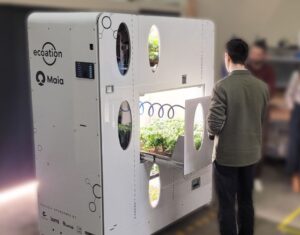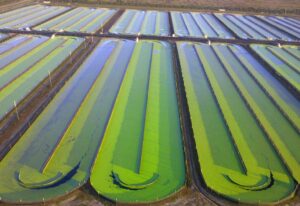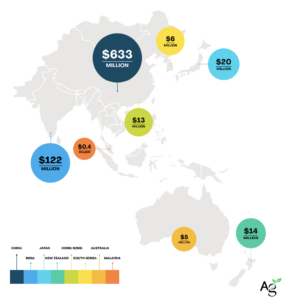Consumer demand for legal cannabis has fueled the growth of the indoor agriculture industry as a whole, particularly when it comes to technological development, according to a new report from Newbean Capital.
While private investment in produce-related indoor ag reached around $80 million in 2015, legal cannabis captured $215 million, according to the report The Impact of Legal Cannabis on the Indoor Agriculture Industry. There are also at least nine times the number of legal cannabis cultivators than indoor produce farms in the US.
“The main takeaway from the report is that the legal cannabis industry is helping to push technological advances that will continue to create opportunities for the rest of the indoor ag community,” Nicola Kerslake, Newbean Capital’s founder, told AgFunderNews.
“Because the price that growers get for their product is significantly higher, legal cannabis growers can innovate more rapidly. They can afford higher costs in the near term and as they innovate, the new technologies will become more efficient and cost-effective for the rest of the industry.”
According to the whitepaper, those involved in the legal cannabis industry are using increasingly sophisticated technologies to grow the plant and operate in the industry.
“For example, we’re seeing some great branding emerging,” Kerslake said. “Looking forward, we hear continued requests for more standardization in packaging and testing, and, of course, a wish for greater clarity on the legal situation in each state.”
Kerslake notes that there have been lessons learned in growing legal cannabis that can help to advance the indoor farming of other crops. The report was written so people can view that as a positive, she added.
“We hope it will encourage those working in legal cannabis and in produce to work together on developing technologies that benefit the entirety of indoor ag,” Kerslake said. “This report could introduce a broader range of people to the potential benefit that indoor-ag can provide, not just for legal cannabis growing, but the broader opportunities for local production of food.”
One key technology used across both cannabis production and food production is lighting. Cannabis cultivators were the first to use LED lights, which dramatically bring costs down; over the last seven years, LEDs have seen a 64 times price/performance ratio increase, according to the report.
Farm management software is another area where cannabis cultivators have led the way, according to the report.
“Mundane tasks such as inventory management, task management, and THC-level testing are daily concerns for growers and are now the focus of software development on both sides of the industry,” reads the report. An early example of this trend is Bright Agrotech’s newly-released Able software, which provides daily task lists to growers, among other features.”
The report also delves into comparisons between business models and investment channels, a major challenge for the indoor agriculture industry as a whole. For cannabis cultivators, it’s been particularly challenging with the complex legal and regulatory framework involved.
But the legal cannabis industry has made use of the natural media attention it attracts to create “increasingly sophisticated” branded products, with high profile celebrities like the rapper Snoop Dogg getting behind them.
With the legal cannabis industry estimated to grow to over $7 billion in the U.S. in 2016, Newbean Capital believes the young industry still has plenty of opportunities and are hoping the report ignites more discussion among those in the indoor ag industry.
“We hope people start talking about some elements we did not address directly in the report—the more legal cannabis is grown in well developed and dedicated indoor farms, the less is grown in illegal indoor spaces that were not built for these operations, or outdoor farms that are causing environmental problems,” Kerslake said.
Read The Impact of Legal Cannabis on the Indoor Agriculture Industry here.
Have news, tips, or a report we should showcase? Email [email protected]

















Sponsored
International Fresh Produce Association launches year 3 of its produce accelerator